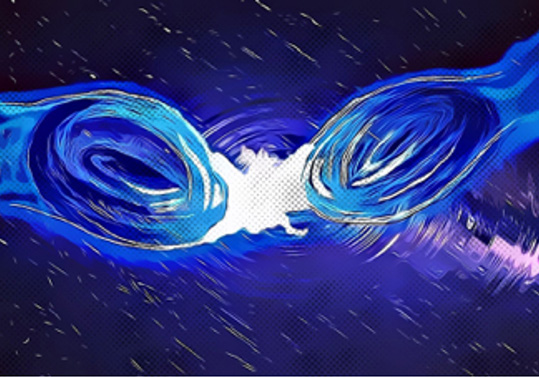Research studies whether the merger of boson stars caused the most massive black hole collision ever observed and prove the existence of dark matter.
- Press Office
- February 24th, 2021

The University of Valencia takes part in a research project, together with the Galician Institute of High Energy Physics (IGFAE) and the University of Aveiro. It shows that the heaviest black hole collision ever observed, produced by the gravitational-wave GW190521, might actually be something even more mysterious: the merger of two boson stars. This would be the first evidence of the existence of these hypothetical objects that constitute one of the main candidates to form dark matter, which makes up 27% of the Universe.
Gravitational waves are ripples in the fabric of spacetime that travel at the speed of light and whose existence was predicted by Einstein in 1961 in the General Theory of Relativity. These waves originate in the most violent events of our Universe, carrying information about their sources.
Since 2015, the humankind can detect and interpret gravitational waves thanks to the two LIGO detectors (Livingston and Hanford, USA) and Virgo (Cascina, Italy) detectors. Despite all the findings gathered in just 6 years, the real potential of gravitational waves goes much further than this. In the future, they could allow the observation of new types of celestial bodies and shed light on basic scientific questions like the nature of dark matter. The latter may, however, have already happened.
On September 2020, the LIGO and Virgo collaborations (LVC) announced observation of the gravitational-wave signal GW190521, which was consistent with the collision of two heavy black holes that produced a final black hole with 142 solar masses. The latter is the first of a new, previously unobserved, black-hole family: intermediate-mass black holes. This discovery is of paramount importance, as such black holes were the missing link between two well-known black-hole families: the stellar-mass black holes that form from the collapse of stars, and the supermassive black holes that hide in the centre of almost every galaxy, including the Milky Way.
The GW190521 also implies a huge challenge. If what we think we know about how stars live and die is correct, the heaviest of the colliding black holes (85 solar masses) could not form from the collapse of a star at the end of its life, which opens up a range of doubts and possibilities about its origin.
In an article published yesterday in Physical Review Letters, a team of scientists in which the University of Valencia takes part, has proposed an alternative origin of the signal GW190521: the collision of two exotic objects known as boson stars. These are one of the most solid candidates to form what we know as dark matter and make up 27% of the Universe, but their composition is not yet known. Assuming such a collision, the team was able to estimate the mass of a new particle constituent of these stars, an ultra-light boson with a mass billionth of times smaller than that of the electron.
The team is led by Juan Calderón Bustillo, from the Galician Institute of High Energy Physics (IGFAE), joint center of the University of Santiago de Compostela and Xunta de Galicia, and Dr. Nicolás Sanchis-Gual, a postdoctoral researcher at the University of Aveiro and the Instituto Superior Técnico (Univ. Lisboa), together with collaborators from University of Valencia, Monash University and The Chinese University of Hong Kong.
The team compared the GW190521 signal to computer simulations of boson-star mergers, and found that these actually explain the data slightly better than the analysis conducted by LIGO and Virgo. The result implies that the source would have different properties than stated earlier. In words of Dr. Calderón Bustillo: 'First, we would not be talking about colliding black holes anymore, which eliminates the issue of dealing with a forbidden black hole. Second, because boson star mergers are much weaker, we infer a much closer distance than the one estimated by LIGO and Virgo. This leads to a much larger mass for the final black hole, of about 250 solar masses, so the fact that we have witnessed the formation of an intermediate-mass black hole remains true'.
Dr. Nicolás Sanchis-Gual, explains: ‘Boson stars are objects almost as compact as black holes but, unlike them, do not have a ‘no-return’ surface. When they collide, they form a boson star that can become unstable, eventually collapsing to a black hole, and producing a signal consistent with what LIGO and Virgo observed. Unlike regular stars, which are made of what we commonly know as matter, boson stars are made up of what we know as ultralight bosons. These bosons are one of the most appealing candidates for constituting what we know as dark matter’.
Like black hole mergers, boson star mergers do not generate electromagnetic waves, i.e. they do not emit light, therefore they can also be studied from their gravitational wave emission. Alejandro Torres-Forné, lecturer at the University of Valencia states: ‘This research demonstrates that the gravitational waves astronomy paves the way to detect new astrophysical objects that could not be observed by classical electromagnetic wave astronomy’.
The team found that even though the analysis tends to favour ‘by design’ the merging black-holes hypothesis, a boson star merger is actually preferred by the data, although in a non-conclusive way. Prof. Jose A. Font from the University of Valencia says: ‘Our statistical analysis shows that are almost indistinguishable given the data, although the exotic boson-star one is slightly preferred. This is very exciting since our boson-star model is as of now very limited and subject to major improvements. A more evolved model may lead to even larger evidence for this scenario and would also allow us to study previous gravitational-wave observations under the boson-star merger assumption.’
This result would not only involve the first observation of boson stars, but also that of their building block, a new particle known as ultra-light boson. Such ultra-light bosons have been proposed as the constituents of what we know as dark matter, which makes up around 27% of the observable Universe. Prof. Carlos Herdeiro, from University of Aveiro adds that ‘one of the most fascinating results is that we can actually measure the mass of this putative new dark-matter particle, and that a value of zero is discarded with high confidence. If confirmed by subsequent analysis of this and other gravitational-wave observations, our result would provide the first observational evidence for a long-sought dark matter candidate’.
References:
- Juan Calderón Bustillo, Nicolas Sanchis-Gual, Alejandro Torres-Forné, José A. Font, Avi Vajpeyi et al. “GW190521 as a merger of Proca stars: a potential new vector boson of 8.7 × 10−13 eV”. Phys. Rev. Lett 126, 081101
https://journals.aps.org/prl/abstract/10.1103/PhysRevLett.126.081101
- Arxiv: https://arxiv.org/abs/2009.05376
















